SUZUKI SWIFT 2000 1.G Transmission Service Repair Manual
Manufacturer: SUZUKI, Model Year: 2000, Model line: SWIFT, Model: SUZUKI SWIFT 2000 1.GPages: 447, PDF Size: 10.54 MB
Page 61 of 447
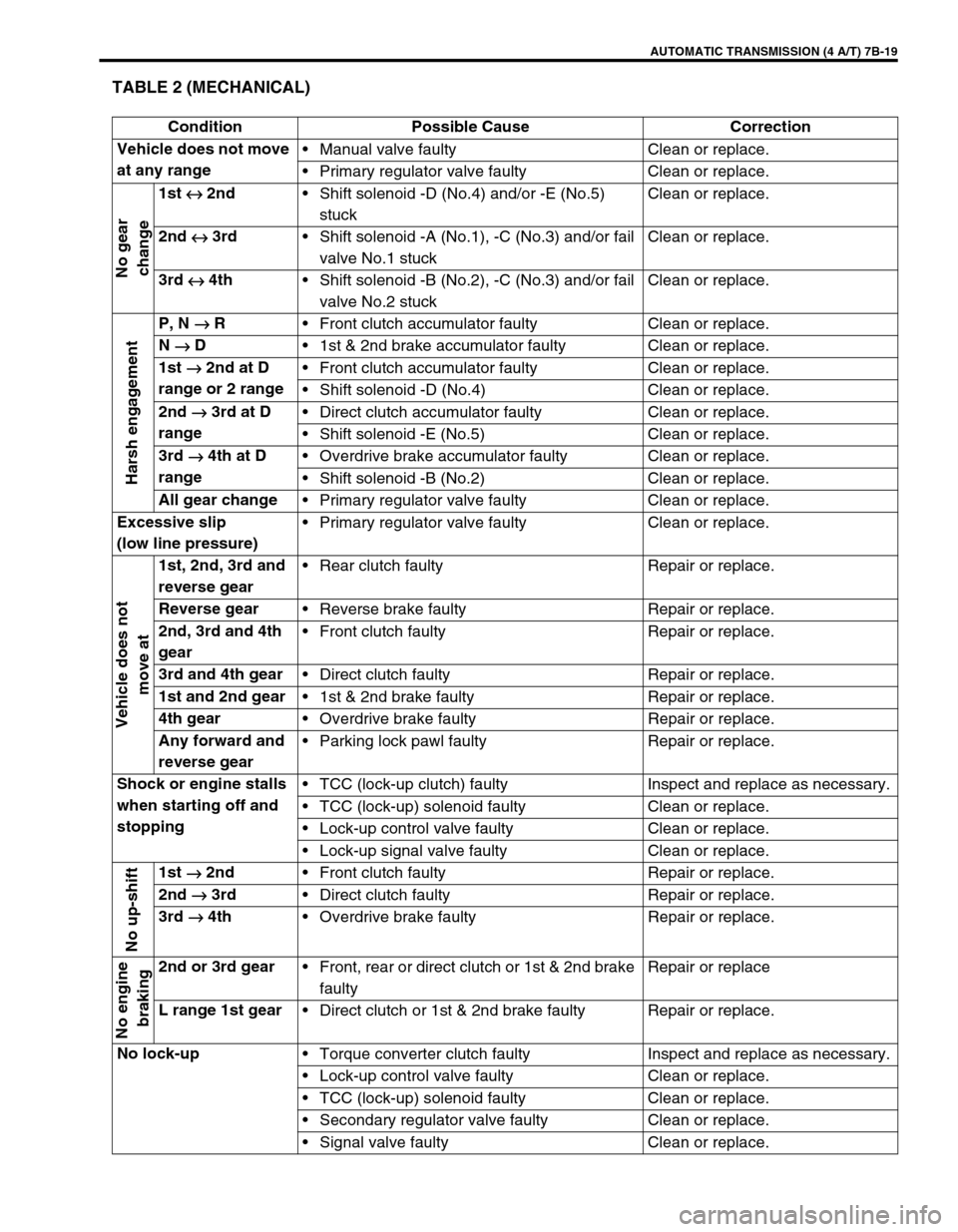
AUTOMATIC TRANSMISSION (4 A/T) 7B-19
TABLE 2 (MECHANICAL)
Condition Possible Cause Correction
Vehicle does not move
at any rangeManual valve faulty Clean or replace.
Primary regulator valve faulty Clean or replace.
No gear
change
1st
↔
↔↔ ↔ 2nd
Shift solenoid -D (No.4) and/or -E (No.5)
stuck Clean or replace.
2nd
↔
↔↔ ↔ 3rd
Shift solenoid -A (No.1), -C (No.3) and/or fail
valve No.1 stuckClean or replace.
3rd
↔
↔↔ ↔ 4th
Shift solenoid -B (No.2), -C (No.3) and/or fail
valve No.2 stuckClean or replace.
Harsh engagement
P, N
→
→→ → R
Front clutch accumulator faulty Clean or replace.
N
→
→→ → D
1st & 2nd brake accumulator faulty Clean or replace.
1st
→
→→ → 2nd at D
range or 2 rangeFront clutch accumulator faulty Clean or replace.
Shift solenoid -D (No.4) Clean or replace.
2nd
→
→→ → 3rd at D
rangeDirect clutch accumulator faulty Clean or replace.
Shift solenoid -E (No.5) Clean or replace.
3rd
→
→→ → 4th at D
rangeOverdrive brake accumulator faulty Clean or replace.
Shift solenoid -B (No.2) Clean or replace.
All gear change
Primary regulator valve faulty Clean or replace.
Excessive slip
(low line pressure)Primary regulator valve faulty Clean or replace.
Vehicle does not
move at
1st, 2nd, 3rd and
reverse gearRear clutch faulty Repair or replace.
Reverse gear
Reverse brake faulty Repair or replace.
2nd, 3rd and 4th
gearFront clutch faulty Repair or replace.
3rd and 4th gear
Direct clutch faulty Repair or replace.
1st and 2nd gear
1st & 2nd brake faulty Repair or replace.
4th gear
Overdrive brake faulty Repair or replace.
Any forward and
reverse gearParking lock pawl faulty Repair or replace.
Shock or engine stalls
when starting off and
stoppingTCC (lock-up clutch) faulty Inspect and replace as necessary.
TCC (lock-up) solenoid faulty Clean or replace.
Lock-up control valve faulty Clean or replace.
Lock-up signal valve faulty Clean or replace.
No up-shift
1st
→
→→ → 2nd
Front clutch faulty Repair or replace.
2nd
→
→→ → 3rd
Direct clutch faulty Repair or replace.
3rd
→
→→ → 4th
Overdrive brake faulty Repair or replace.
No engine
braking
2nd or 3rd gear
Front, rear or direct clutch or 1st & 2nd brake
faultyRepair or replace
L range 1st gear
Direct clutch or 1st & 2nd brake faulty Repair or replace.
No lock-up
Torque converter clutch faulty Inspect and replace as necessary.
Lock-up control valve faulty Clean or replace.
TCC (lock-up) solenoid faulty Clean or replace.
Secondary regulator valve faulty Clean or replace.
Signal valve faulty Clean or replace.
Page 62 of 447
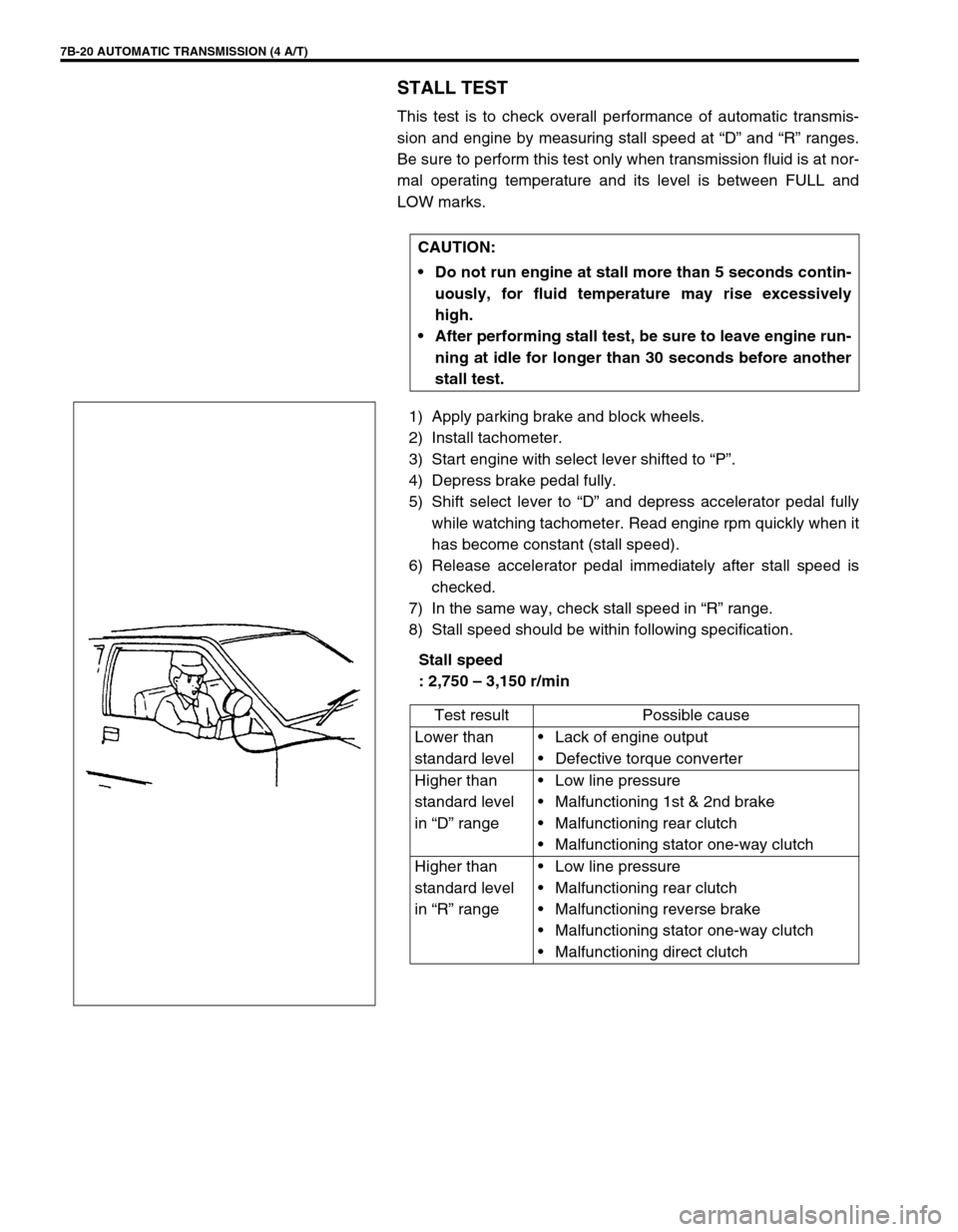
7B-20 AUTOMATIC TRANSMISSION (4 A/T)
STALL TEST
This test is to check overall performance of automatic transmis-
sion and engine by measuring stall speed at “D” and “R” ranges.
Be sure to perform this test only when transmission fluid is at nor-
mal operating temperature and its level is between FULL and
LOW marks.
1) Apply parking brake and block wheels.
2) Install tachometer.
3) Start engine with select lever shifted to “P”.
4) Depress brake pedal fully.
5) Shift select lever to “D” and depress accelerator pedal fully
while watching tachometer. Read engine rpm quickly when it
has become constant (stall speed).
6) Release accelerator pedal immediately after stall speed is
checked.
7) In the same way, check stall speed in “R” range.
8) Stall speed should be within following specification.
Stall speed
: 2,750 – 3,150 r/min CAUTION:
Do not run engine at stall more than 5 seconds contin-
uously, for fluid temperature may rise excessively
high.
After performing stall test, be sure to leave engine run-
ning at idle for longer than 30 seconds before another
stall test.
Test result Possible cause
Lower than
standard levelLack of engine output
Defective torque converter
Higher than
standard level
in “D” rangeLow line pressure
Malfunctioning 1st & 2nd brake
Malfunctioning rear clutch
Malfunctioning stator one-way clutch
Higher than
standard level
in “R” rangeLow line pressure
Malfunctioning rear clutch
Malfunctioning reverse brake
Malfunctioning stator one-way clutch
Malfunctioning direct clutch
Page 63 of 447
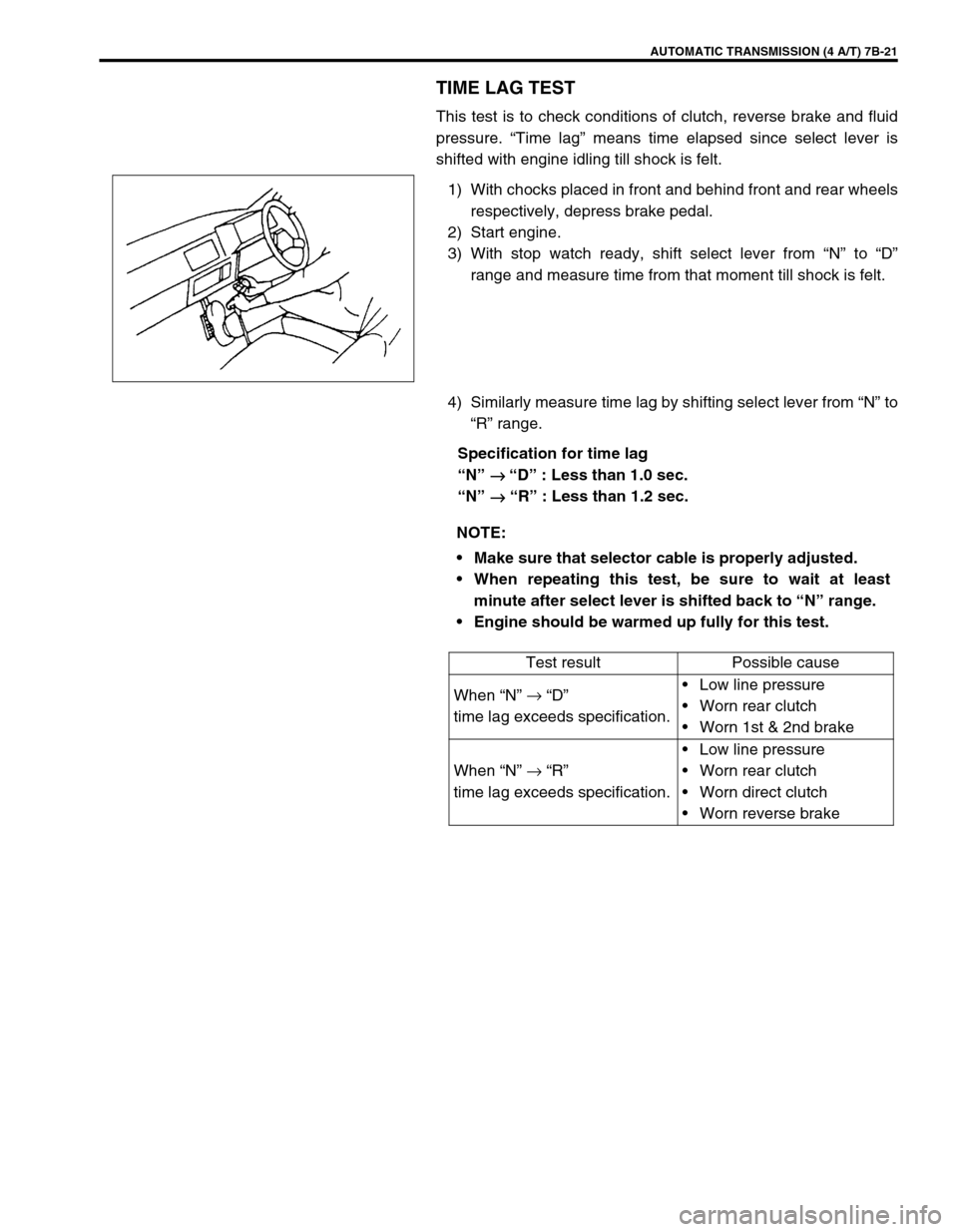
AUTOMATIC TRANSMISSION (4 A/T) 7B-21
TIME LAG TEST
This test is to check conditions of clutch, reverse brake and fluid
pressure. “Time lag” means time elapsed since select lever is
shifted with engine idling till shock is felt.
1) With chocks placed in front and behind front and rear wheels
respectively, depress brake pedal.
2) Start engine.
3) With stop watch ready, shift select lever from “N” to “D”
range and measure time from that moment till shock is felt.
4) Similarly measure time lag by shifting select lever from “N” to
“R” range.
Specification for time lag
“N”
→
→ → → “D” : Less than 1.0 sec.
“N”
→
→→ → “R” : Less than 1.2 sec.
NOTE:
Make sure that selector cable is properly adjusted.
When repeating this test, be sure to wait at least
minute after select lever is shifted back to “N” range.
Engine should be warmed up fully for this test.
Test result Possible cause
When “N” →
“D”
time lag exceeds specification.Low line pressure
Worn rear clutch
Worn 1st & 2nd brake
When “N” →
“R”
time lag exceeds specification.Low line pressure
Worn rear clutch
Worn direct clutch
Worn reverse brake
Page 64 of 447
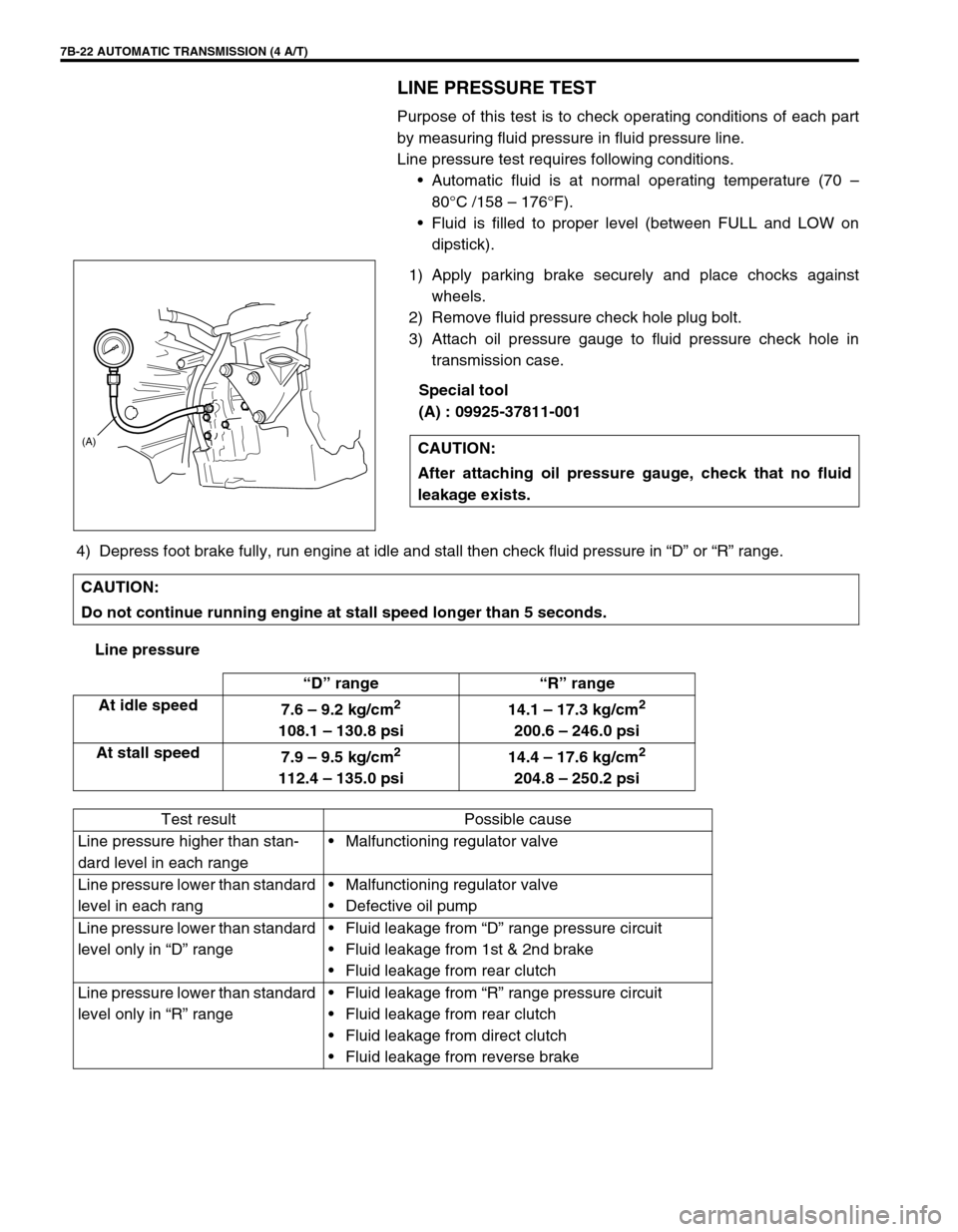
7B-22 AUTOMATIC TRANSMISSION (4 A/T)
LINE PRESSURE TEST
Purpose of this test is to check operating conditions of each part
by measuring fluid pressure in fluid pressure line.
Line pressure test requires following conditions.
Automatic fluid is at normal operating temperature (70 –
80°C /158 – 176°F).
Fluid is filled to proper level (between FULL and LOW on
dipstick).
1) Apply parking brake securely and place chocks against
wheels.
2) Remove fluid pressure check hole plug bolt.
3) Attach oil pressure gauge to fluid pressure check hole in
transmission case.
Special tool
(A) : 09925-37811-001
4) Depress foot brake fully, run engine at idle and stall then check fluid pressure in “D” or “R” range.
Line pressureCAUTION:
After attaching oil pressure gauge, check that no fluid
leakage exists.
(A)
CAUTION:
Do not continue running engine at stall speed longer than 5 seconds.
“D” range “R” range
At idle speed
7.6 – 9.2 kg/cm
2
108.1 – 130.8 psi14.1 – 17.3 kg/cm
2
200.6 – 246.0 psi
At stall speed
7.9 – 9.5 kg/cm
2
112.4 – 135.0 psi14.4 – 17.6 kg/cm
2
204.8 – 250.2 psi
Test result Possible cause
Line pressure higher than stan-
dard level in each rangeMalfunctioning regulator valve
Line pressure lower than standard
level in each rangMalfunctioning regulator valve
Defective oil pump
Line pressure lower than standard
level only in “D” rangeFluid leakage from “D” range pressure circuit
Fluid leakage from 1st & 2nd brake
Fluid leakage from rear clutch
Line pressure lower than standard
level only in “R” rangeFluid leakage from “R” range pressure circuit
Fluid leakage from rear clutch
Fluid leakage from direct clutch
Fluid leakage from reverse brake
Page 65 of 447
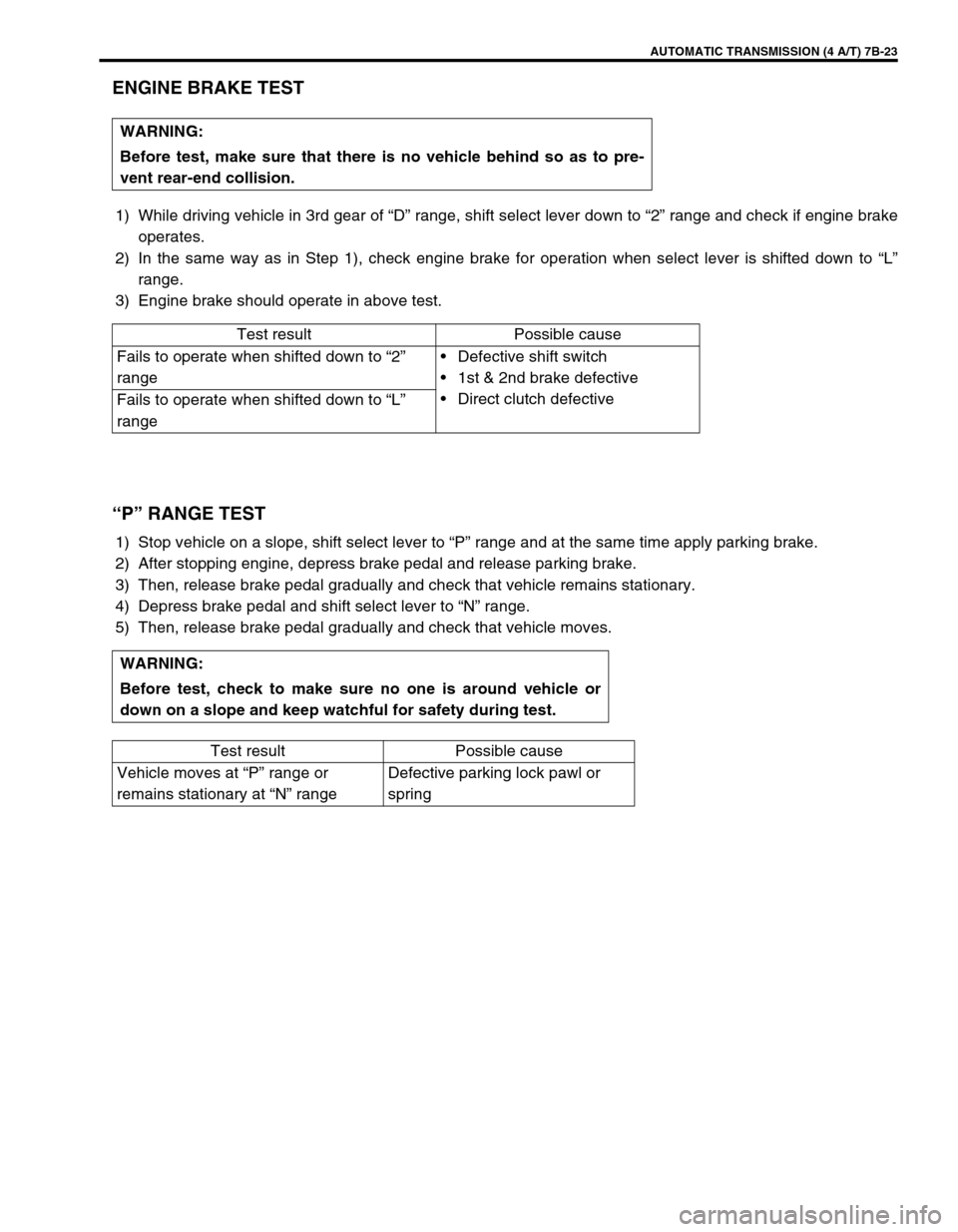
AUTOMATIC TRANSMISSION (4 A/T) 7B-23
ENGINE BRAKE TEST
1) While driving vehicle in 3rd gear of “D” range, shift select lever down to “2” range and check if engine brake
operates.
2) In the same way as in Step 1), check engine brake for operation when select lever is shifted down to “L”
range.
3) Engine brake should operate in above test.
“P” RANGE TEST
1) Stop vehicle on a slope, shift select lever to “P” range and at the same time apply parking brake.
2) After stopping engine, depress brake pedal and release parking brake.
3) Then, release brake pedal gradually and check that vehicle remains stationary.
4) Depress brake pedal and shift select lever to “N” range.
5) Then, release brake pedal gradually and check that vehicle moves.WARNING:
Before test, make sure that there is no vehicle behind so as to pre-
vent rear-end collision.
Test result Possible cause
Fails to operate when shifted down to “2”
rangeDefective shift switch
1st & 2nd brake defective
Direct clutch defective
Fails to operate when shifted down to “L”
range
WARNING:
Before test, check to make sure no one is around vehicle or
down on a slope and keep watchful for safety during test.
Test result Possible cause
Vehicle moves at “P” range or
remains stationary at “N” rangeDefective parking lock pawl or
spring
Page 66 of 447
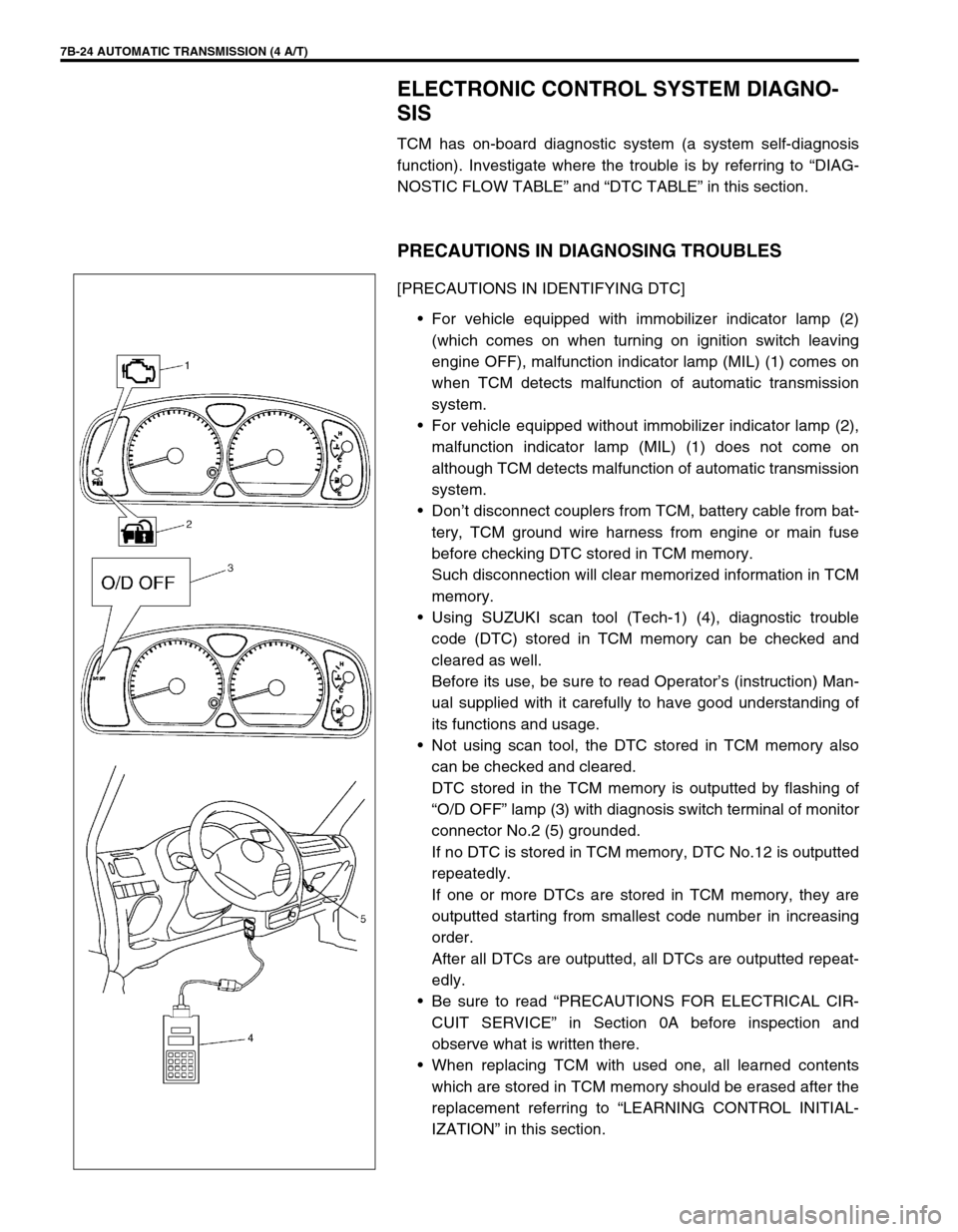
7B-24 AUTOMATIC TRANSMISSION (4 A/T)
ELECTRONIC CONTROL SYSTEM DIAGNO-
SIS
TCM has on-board diagnostic system (a system self-diagnosis
function). Investigate where the trouble is by referring to “DIAG-
NOSTIC FLOW TABLE” and “DTC TABLE” in this section.
PRECAUTIONS IN DIAGNOSING TROUBLES
[PRECAUTIONS IN IDENTIFYING DTC]
For vehicle equipped with immobilizer indicator lamp (2)
(which comes on when turning on ignition switch leaving
engine OFF), malfunction indicator lamp (MIL) (1) comes on
when TCM detects malfunction of automatic transmission
system.
For vehicle equipped without immobilizer indicator lamp (2),
malfunction indicator lamp (MIL) (1) does not come on
although TCM detects malfunction of automatic transmission
system.
Don’t disconnect couplers from TCM, battery cable from bat-
tery, TCM ground wire harness from engine or main fuse
before checking DTC stored in TCM memory.
Such disconnection will clear memorized information in TCM
memory.
Using SUZUKI scan tool (Tech-1) (4), diagnostic trouble
code (DTC) stored in TCM memory can be checked and
cleared as well.
Before its use, be sure to read Operator’s (instruction) Man-
ual supplied with it carefully to have good understanding of
its functions and usage.
Not using scan tool, the DTC stored in TCM memory also
can be checked and cleared.
DTC stored in the TCM memory is outputted by flashing of
“O/D OFF” lamp (3) with diagnosis switch terminal of monitor
connector No.2 (5) grounded.
If no DTC is stored in TCM memory, DTC No.12 is outputted
repeatedly.
If one or more DTCs are stored in TCM memory, they are
outputted starting from smallest code number in increasing
order.
After all DTCs are outputted, all DTCs are outputted repeat-
edly.
Be sure to read “PRECAUTIONS FOR ELECTRICAL CIR-
CUIT SERVICE” in Section 0A before inspection and
observe what is written there.
When replacing TCM with used one, all learned contents
which are stored in TCM memory should be erased after the
replacement referring to “LEARNING CONTROL INITIAL-
IZATION” in this section.
Page 67 of 447
![SUZUKI SWIFT 2000 1.G Transmission Service Repair Manual AUTOMATIC TRANSMISSION (4 A/T) 7B-25
[INTERMITTENT TROUBLES] and [NOTES ON SYSTEM CIR-
CUIT INSPECTION]
Refer to Section 0A.
DTC CHECK
[Check DTC with SUZUKI scan tool]
1) Turn ignition switch OFF.
2) SUZUKI SWIFT 2000 1.G Transmission Service Repair Manual AUTOMATIC TRANSMISSION (4 A/T) 7B-25
[INTERMITTENT TROUBLES] and [NOTES ON SYSTEM CIR-
CUIT INSPECTION]
Refer to Section 0A.
DTC CHECK
[Check DTC with SUZUKI scan tool]
1) Turn ignition switch OFF.
2)](/img/20/7605/w960_7605-66.png)
AUTOMATIC TRANSMISSION (4 A/T) 7B-25
[INTERMITTENT TROUBLES] and [NOTES ON SYSTEM CIR-
CUIT INSPECTION]
Refer to Section 0A.
DTC CHECK
[Check DTC with SUZUKI scan tool]
1) Turn ignition switch OFF.
2) After setting cartridge, connect SUZUKI scan tool to data link
connector (DLC) (1) located on underside of instrument
panel at driver’s seat side.
Special tool
(A) : 09931-76011 (SUZUKI scan tool)
(B) : Mass storage cartridge
(C) : 09931-76030 (16/14 pin DLC cable)
3) Turn ignition switch ON.
4) Read DTC according to instructions displayed on SUZUKI
scan tool and print it or write it down. Refer to SUZUKI scan
tool operator’s manual for further details.
5) After completing the check, turn ignition switch OFF and dis-
connect SUZUKI scan tool from data link connector (DLC)
(1).
[Check DTC without SUZUKI scan tool]
1) Turn ignition switch ON and make sure that O/D OFF lamp is
OFF in combination meter (O/D off switch OFF).
2) Turn ignition switch OFF.
3) Pull out clip (3) and remove glove box (2) from instrument
panel (1).
Page 68 of 447

7B-26 AUTOMATIC TRANSMISSION (4 A/T)
4) Using service wire, ground diagnosis switch terminal (2) of
monitor connector No.2 (1).
5) Turn ignition switch ON.
6) Read DTC from flashing pattern of O/D OFF lamp.
7) After completing the DTC check, turn ignition switch OFF
and disconnect service wire from monitor connector No.2
(1).
3. Ground terminal
1
2
3
Page 69 of 447
![SUZUKI SWIFT 2000 1.G Transmission Service Repair Manual AUTOMATIC TRANSMISSION (4 A/T) 7B-27
DTC CLEARANCE
[Clear DTC with SUZUKI scan tool]
1) Turn ignition switch OFF.
2) After setting cartridge to scan tool, connect it to data link
connector (DLC) (1) l SUZUKI SWIFT 2000 1.G Transmission Service Repair Manual AUTOMATIC TRANSMISSION (4 A/T) 7B-27
DTC CLEARANCE
[Clear DTC with SUZUKI scan tool]
1) Turn ignition switch OFF.
2) After setting cartridge to scan tool, connect it to data link
connector (DLC) (1) l](/img/20/7605/w960_7605-68.png)
AUTOMATIC TRANSMISSION (4 A/T) 7B-27
DTC CLEARANCE
[Clear DTC with SUZUKI scan tool]
1) Turn ignition switch OFF.
2) After setting cartridge to scan tool, connect it to data link
connector (DLC) (1) located on underside of instrument
panel at driver’s seat side.
Special tool
(A) : 09931-76011 (SUZUKI scan tool)
(B) : Mass storage cartridge
(C) : 09931-76030 (16/14 pin DLC cable)
3) Turn ignition switch ON.
4) Erase DTC according to instructions displayed on scan tool.
Refer to SUZUKI scan tool operator’s manual for further
details.
5) After completing the clearance, turn ignition switch OFF and
disconnect scan tool from data link connector (DLC) (1).
[Clear DTC without SUZUKI scan tool]
1) Turn ignition switch ON.
2) Using service wire, ground diagnosis switch terminal (2) of
monitor connector No.2 (1) five times within 10 seconds.
3) Perform “DTC check” and confirm that only DTC12 (normal
DTC) is displayed. If not, repeat step 1) and 2) and check
again.
3. Ground terminal
1
2
3
Page 70 of 447

7B-28 AUTOMATIC TRANSMISSION (4 A/T)
DTC TABLE
DTC NO.
“O/D OFF” Lamp
Flashing Pattern of DTC
(Not using scan tool)DETECTING ITEMSMIL
Using
scan toolNot using
scan toolVehicle
equipped
with
immobi-
lizer indi-
cator lampVehicle
equipped
without
immobi-
lizer indi-
cator lamp
–12 Normal––
P0715 14Input/Turbine speed sensor circuit
malfunction1 driving
cycleNot
applicable
P0730 18 Incorrect gear ratio2 driving
cyclesNot
applicable
P075321
Shift solenoid-A (No.1) electrical1 driving
cycleNot
applicable
22
P075823
Shift solenoid-B (No.2) electrical1 driving
cycleNot
applicable
24
P0763 43 Shift solenoid-C (No.3) electrical1 driving
cycleNot
applicable
P0768 45 Shift solenoid-D (No.4) electrical1 driving
cycleNot
applicable
P0773 48 Shift solenoid-E (No.5) electrical1 driving
cycleNot
applicable
P074325
Torque converter clutch (lock-up)
system electrical1 driving
cycleNot
applicable
26